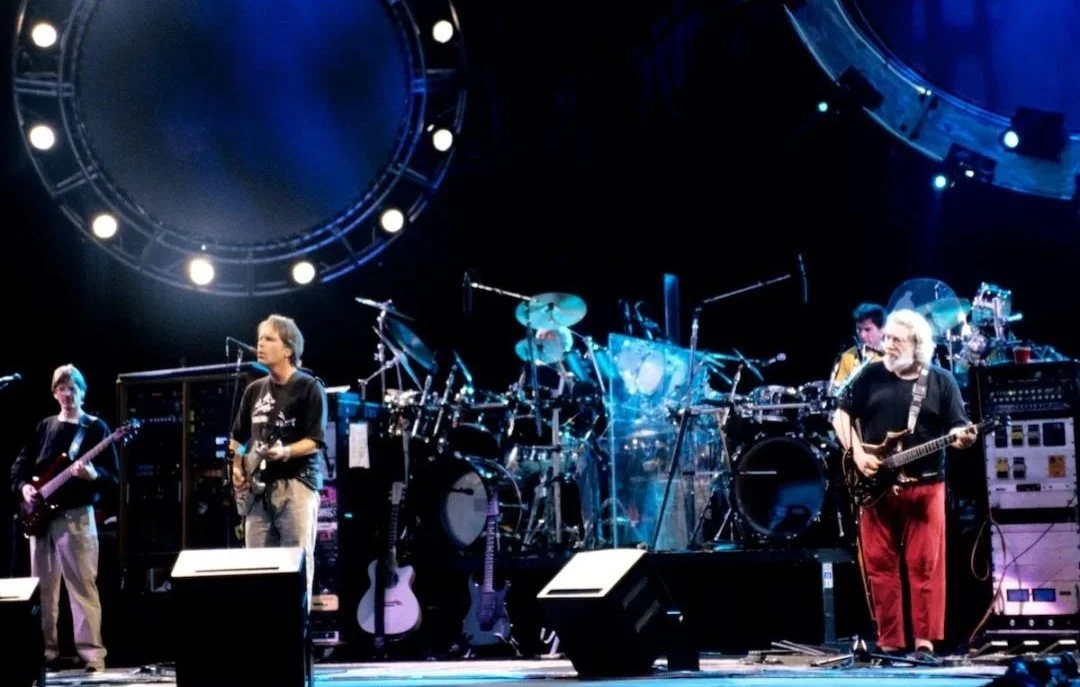Weekend at Garcia’s - Last Days of the Dead
One of the driest summers on record in the US since the horrendous heat on the country’s 200th birthday in 1976, a well-documented non-precipitation that simultaneously kicked the skateboarding culture into high gear on the Westside of LA that same year, 1995 marked a historic high not just on the wicked weather that cursed the climate of the decade’s mid-point, but for an iconic institution celebrating their 30th anniversary in revolutionary sound, the Grateful Dead. With the band’s critical community growing in numbers, while their harmonious history, and lysergical legacy peaking, literally, at an all-time high, also literally, the Dead were climbing the metaphysical mountains, piercing through a landscape eagerly established by their very own energy, and investments into the lyrical intuitions carefully crafted over the decades like no other. Who are you? Where are you? How are you? Supplying the carefully curated sonic spiritualism to its newly adultescent audience that quickly shifted into what a lot of veteran Dead Heads would describe as becoming more ‘harsh, party-influenced, and bro-ey’ halfway through the Garcia era in the late 1980s, and early 1990s, the band set off on a near two-month, 26-date spring/summer run on the East Coast, attempting to cosmically conquer the conditions of what would later be known as the ‘Tour from Hell.’ With equipment problems seemingly waiting for the band right out at the gate, Garcia had to switch out his iconic “Rosebud” guitar for his older, and even more iconic, “Tiger” to push through the set.
“I’d rather have my immortality here while I’m alive.” I don’t care if it lasts beyond me at all. I’d just as soon it didn’t.”
Accompanied by The Band, the Dead closed the ‘Tour of Doom’, playing two nights in the Windy City at Soldier Field, the first time since their debut in 1991. Marking the end of an era, not only could God himself have predicted, even though he wrote the band’s biblical tale, the group, and its members Phil Lesh, Bob Weir, Bill Kreutzmann, Mickey Hart, and keyboardist Vince Welnick took the stage for the last time as the universal unit on July 8th and 9th to continue the brave battle of delivering their final two sets with Jerome John Garcia as the band’s founding member, front-man, and soothing storyteller for the last 30 years. From the infamous gatecrashing incident and blocking the band’s buses during their departure at Deer Creek in Indiana, which led to the cancellation of their second show, as well as the release of a very stern letter directly to their fans before the first of two concerts at Riverport Amphitheater outside St. Louis—where hundreds of audience members were seriously injured, including one who was completely paralyzed after a campground structure collapsed—at Riverport Amphitheatre, a death threat was sent to Garcia the very same day, which the FBI and local police found legitimate enough to ask the band to play with the stage lights on for the entire evening. Three patrons were struck by lightning before one of the two shows at RFK Stadium in Washington, D.C., where they were opening for Dylan. The temptation of ticketless Deadheads crashing the tour’s opener in Vermont, along with the band’s ongoing struggles reaching a boiling point, made summer of ‘95 a turbulent start—an end that was seemingly approaching. Like a runaway train heading toward disaster that you’d do anything to escape, the band appeared to be heading for catastrophe as their behind-the-scenes responsibilities began to take a terrible toll on its members, family, crew, and close friends. The financial pressure—roughly half a million dollars a month—propelled the band into an endless hellscape of touring month after month, year after year.
Performing for their prolifically adoring fans, both new and old, there’s a painfully public price to pay for being a band this long. So much had changed within their creative core since 1965, but one thing was for certain: the desire to share sound and spiritual signals with their atmospheric attendees was always a poetic priority. As the summer heat began to settle in, the next 48 hours, for those so keen to witness in person, would soon break that special stellar streak in the cultural cosmos for the whole world to see as the band took the stage on July 9th to play their last show together. Displaying a dynamic set that featured tracks such as “When I Paint My Masterpiece,” a Dylan cut, who was both close and important to the band throughout their career, the set’s optimistic opener “Touch Of Grey,” “Unbroken Chain," a rare card pulled from the ‘Lesh Zone,’ “So Many Roads,” perhaps the greatest rendition of the already melodic masterpiece, and “Box Of Rain,” the last song of the encore sang b Lesh to finish out the numbing night. If you’re not a fan of the Grateful Dead, then some of this information may come as a surprise to you. While most people alive today know of Garcia’s untimely passing, precisely one month after the Soldier Field shows, it should be clear that the band’s liberating legacy didn’t just go up in fiery flames after 1995, but instead has been eagerly explored, and expanded upon over the last 30 years by its survivings members, and close company for the band’s mid-point in what’s make their 60th anniversary possible this year. With over 2,000 shows under their belt, in the words of Garcia, it was “always a hoot.”





